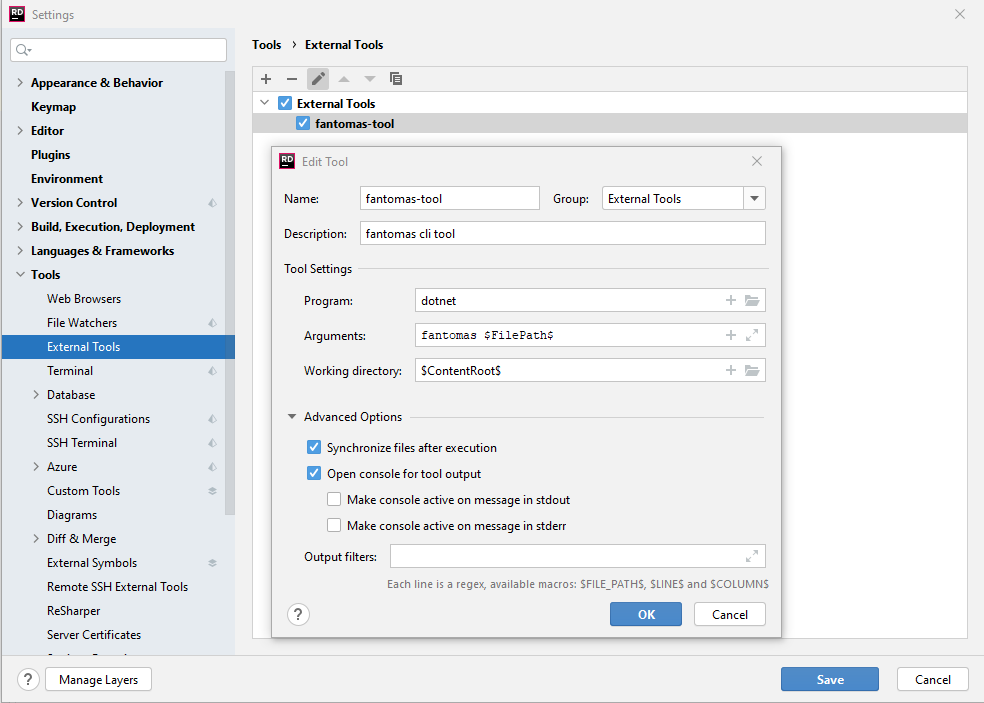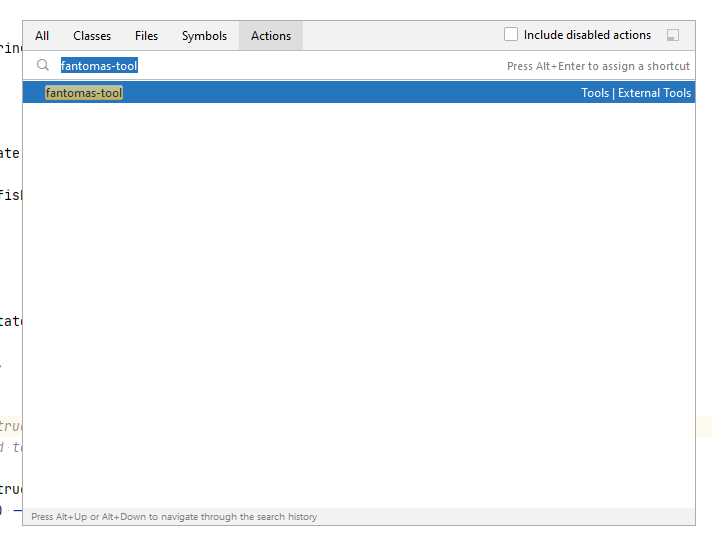F# source code formatter, inspired by scalariform for Scala, ocp-indent for OCaml and PythonTidy for Python.
Use this command to install Fantomas as a .NET 5 SDK global tool:
dotnet tool install -g fantomas-tool
For detailed guidelines, please read Fantomas: How to use.
Fantomas can be easily integrated with FAKE build system.
Check out the sample.
The fsharp-support uses fantomas under the hood to format the source code. No need for any additional plugins.
For technical reasons Rider cannot always use the latest version of Fantomas found on NuGet. As a workaround you could install fantomas-tool and configure it as an External tool.
dotnet tool install fantomas-tool
This will have an impact on your editing experiencing in Rider, the external change to the file by the command line application might trigger more internal logic inside Rider than necessary. It could be noticeable in regards to the default formatting experience.
The recommended way to use Fantomas is by using the Ionide plugin. Fantomas is integrated in FSAutoComplete which is the language server used by Ionide.
Alternatively, you can install the fantomas-fmt extension.
The F# Formatting extension sets up Fantomas as the default formatter for F# files, configurable from Visual Studio's options.
Try the Fantomas online.
Every once in a while an alpha or beta version is published to https://www.nuget.org/.
Our previous MyGet feed is now deprecated.
Some figures can be found at https://fsprojects.github.io/fantomas/
We use BenchmarkDotNet to collect data for each build on the master branch.
This project aims at formatting F# source files based on a given configuration. Fantomas will ensure correct indentation and consistent spacing between elements in the source files. We assume that the source files are parsable by F# compiler before feeding into the tool. Fantomas follows the formatting guideline being described in A comprehensive guide to F# Formatting Conventions.
The project is developed with the following use cases in mind:
-
Reformatting an unfamiliar code base. It gives readability when you are not the one originally writing the code. To illustrate, the following example
type Type = TyLam of Type * Type | TyVar of string | TyCon of string * Type list with override this.ToString () = match this with | TyLam (t1, t2) -> sprintf "(%s -> %s)" (t1.ToString()) (t2.ToString()) | TyVar a -> a | TyCon (s, ts) -> s
will be rewritten to
type Type = | TyLam of Type * Type | TyVar of string | TyCon of string * Type list override this.ToString() = match this with | TyLam(t1, t2) -> sprintf "(%s -> %s)" (t1.ToString()) (t2.ToString()) | TyVar a -> a | TyCon(s, ts) -> s
-
Converting from verbose syntax to light syntax. Feeding a source file in verbose mode, Fantomas will format it appropriately in light mode. This might be helpful for code generation since generating verbose source files is much easier. For example, this code fragment
let Multiple9x9 () = for i in 1 .. 9 do printf "\n"; for j in 1 .. 9 do let k = i * j in printf "%d x %d = %2d " i j k; done; done;; Multiple9x9 ();;
is reformulated to
let Multiple9x9() = for i in 1..9 do printf "\n" for j in 1..9 do let k = i * j printf "%d x %d = %2d " i j k Multiple9x9()
-
Formatting F# signatures, especially those generated by F# compiler and F# Interactive.
For more complex examples, please take a look at F# outputs of 20 language shootout programs and 10 CodeReview.SE source files.
There are a few reasons to choose the name as such. First, it starts with an "F" just like many other F# projects. Second, Fantomas is my favourite character in the literature. Finally, Fantomas has the same Greek root as "phantom"; coincidentally F# ASTs and formatting rules are so mysterious to be handled correctly.
See the Contribution Guidelines.
We would like to gratefully thank the following persons for their contributions.
- Eric Taucher
- Steffen Forkmann
- Jack Pappas
- Ivan Towlson
- Don Syme
- Gustavo Guerra
- Jared Parsons
- Denis Ok
- Enrico Sada
The library and tool are available under Apache 2.0 license. For more information see the License file.


